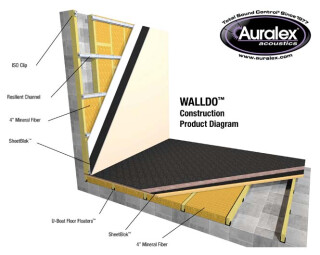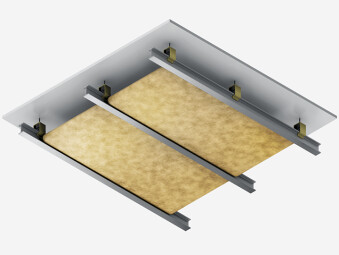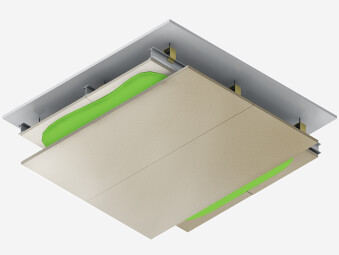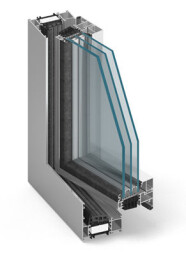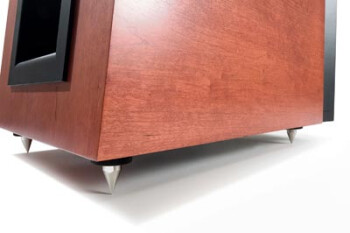After the theoretical review of the last article, today we'll start getting our hands dirty keeping in mind that there are as many different home studios as there are home studio owners.
Let’s start with the few lucky people who have a 300 sq ft room and 30,000 bucks to invest in it. If you are one of them, the solution is very easy: You only need to call a company specializing in soundproofing and acoustic treatment to carry out all the necessary work in your new studio. This approach will obviously be the best in terms of quality, since all the work will be made based on the measurements and judgment of an acoustics expert who will suggest the most appropriate solutions according to the room and your needs.
If your budget is somewhat lower, you will have to roll up your sleeves and go step by step: first the soundproofing and then the acoustic treatment even if, as we already saw, you can start working on the acoustics during the soundproofing stage.
I do warn you, though, this is by no means a tutorial describing every little detail you have to do and buy, sorry. And there are three very good reasons for that: First, I’m not a professional acoustician nor a construction specialist. Second, given the heterogeneity of home studios and home studio owners, it would be impossible for me to even try to do something else than approach this in a general way. Third, many musicians don’t have the means nor the possibilities to do such work, and I don’t want to exclude them from the discussion. Okay, here we go!
Ideal soundproofing
Soundproofing basically means keeping the sound waves where you want them and stop them from leaving the room you are working in. The good news is that once you achieve either of these goals you’ve achieved the other one, too: when you soundproof a room you avoid noise from being heard outside of the room, but you also avoid external noises from making their way into the room. You soundproof for the sake of your neighbors and the people you live with, but also to stop the noise they and the subway one block down produce from compromising the silence of your music haven.
The simplest way to stop a sound wave is to put in front of it a mass as solid and stiff as possible so that it doesn’t transmit any waves. Which is something very easy to do, as long as the foundations of your building can withstand several dozens of tonnes so you can fit in 7 ft thick marble walls, ceiling and floor.
You are not Julius Caesar by any chance now, are you? I thought so. Keep on reading then.
In most cases the best way to go would be to build a “room inside a room.” That’s actually the only way to get a quality soundproofing, even if it means significantly reducing the area and volume of the original room. The principle is simple: you detach the floor, walls and ceiling from the original room so that vibrations are reduced to the minimum (perfect soundproofing doesn’t exist). To achieve that you need to put around all walls, ceiling and floor 1 ft of vibration isolators (called SilentBlocs after the first product of the type introduced by French company Paulstra), which will carry some rails.
Thanks to the latter you will be able to place very dense (about 50kg/m3) acoustic rockwool several inches thick, leaving a gap of at least 20 inches between the rockwool and the walls. You then have to create a sort of acoustic sandwich with two BA13-type plasterboards and a shock absorbing material like the Auralex Sheetblock, for example.
The same applies to the floor and suspended ceiling, except that the isolators and the components of the sandwich change. I wouldn’t dream of giving you the recipe for the perfect acoustic sandwich because everybody has his/her own way of doing things: you could, for instance, fix fiberglass on the wall with brackets and then have the vibration isolators and air gap. But in the end, it’s almost always the mix of the same ingredients.
| Image source: Acoustique & Décibels |
A cheaper solution is often used my home studio owners: Placing brackets on the wall and the ceiling with rockwool and then cover it all with fabric, ideally with some sort of acoustic fabric, although many people settle for good ol’ gunny. That’s certainly better than nothing for a reasonable price, but it won’t do much to reduce the sound from a drum kit, even less so if the floor isn’t acoustically treated (see text box).
By now you have surely realized that the room inside a room concept isn’t a walk in the park, but apart from the marble walls I told you about in the beginning, this is the only way to get a good soundproofing to protect your neighbors from the sound coming from your studio and you from the noises they make. And it’s also the perfect opportunity to foresee acoustic problems.
In the previous article I mentioned that a room with specific proportions can guarantee better acoustics (the Sepmeyer ratio, for instance). And it’s definitely now that you need to think about that because even if it means putting up divisions and a suspended ceiling, the size of the air gap between them and the real walls can play a crucial role when rethinking the new dimensions of your studio to try to make it more like the ideal room described by the experts.
It might also be the right moment to fight against flutter echoes by doing away with parallel walls, slanting a wall a bit, for instance. Or you can also smoothen out straight angles even if, as Jimbass points out in the comments to this article, these angles can also be useful to install other sorts of treatments later on.
The door (ideally there should be only one of them) and the windows (if any, because they can be a real pain acoustically speaking), ought to have some sort of acoustic treatment, too, otherwise all other actions you take will go down the drain.
Doors and windows
Let’s start with any eventual windows your room might have. Don’t waste your time and money on putting a second pane to your old windows: the improvements this provides are insignificant, both from a thermal and acoustic point of view. Double-glazed windows, on the other hand, can prove really effective.
But be careful because when it comes to double-glazed windows it’s a mixed bag. While all such windows work under the same principle of using a chemically inert gas (argon, which does not transmit the movement of molecules) between two panes, the thickness of the latter, as well as the use of an additional isolating film can really make a difference. In the best of cases, a third pane is used to add yet another layer of argon, making it much more effective. The problem is that the more the insulation the window provides, the more expensive it is: it can range from somewhere around $100 to up to $300 per square meter, without installation. If you own the place, it’s definitely worth considering, but if you are only renting and the owner doesn’t want to hear anything about it, the high cost will probably make you change your mind quite quickly.
Let’s finish with the door, where the most common approach is to use two really heavy doors (to create, once again, an acoustic sandwich) and an adequate door frame. Again, it comes at a price, but if you want good soundproofing you’re going to have to pay the price.
I imagine many of you started scratching your heads when I told you that, ideally, your studio shouldn’t have any windows, especially considering that you wanted to have a big nice window between the control room and the studio itself.
Let me be clear on this point: it’s obviously better, when you have the possibility, to isolate the place where you monitor and mix from the place where you record. That’s the way it’s done in all professional studios. If you think you have enough space to do it, go ahead, as long as that doesn’t mean having a 21 sq ft room with no room for your speakers. In that case it’s better to have a real control room with a small recording booth (small enough so you can record vocals or guitars in it, and demountable if possible) to favor comfort within the room where you will listen and mix whatever you record.
Assuming that you have a place big enough for a 215sq ft control room and a recording room just as big, keep in mind that it means yet another door to soundproof and that this glass will give you more than a headache, be it in terms of acoustics or soundproofing. Nothing is unsurmountable, especially if you have enough money, but if you want to keep the costs down, you might want to settle for a skylight or, even cheaper and easier, two small video cameras and screens.
And with this we are done with the place itself and it’s time to move on to the acoustic treatment, but before we do that there are a couple of details I would like to address at this stage. The first one is regarding electricity…
You’ve got the Power
Make sure that you have power outlets where you need them in the room, earthed obviously and using another power line that’s not connected to your home’s main power line. Plugging your studio to the same power line as your kitchen is looking for trouble. If it’s no possible (and even if it is) I strongly recommend you to get yourself a power regulator/stabilizer and an inverter. This could spare you some ugly surprises afterwards, be it protecting your gear from voltage variations and power cuts or making sure that the current you are using is the “most adequate” possible, in other words that it’s free from interference.
Furman is one of the experts in this regard and offers lots of different options for all your needs, from modest to professional products. They will obviously cost you more than a couple of power strips at Walmart but trust me, it’s worth it. It’s not very pleasant to see your hard drive become a brick due to a power cut. I have personally seen the PSU of a PC blow up before my eyes (yes, and I mean that literally!) as a result of a power surge. Not to mention that one of the most common issues in home studios is the presence of hum and other noises that can’t be traced. The use of tools like the ones I mentioned above will allow you to reduce the possibilities if you ever bump into such a problem.
And since we are talking about electricity, let’s talk about light: For the sake of the environment, and your electricity bill, plus the voltage variations they produce, don’t use halogen lamps. Low-consumption and LED lamps have evolved so much in recent years that there’s no need to use such energy-hungry and heat-producing devices.
Because you should not neglect the heat and ventilation in your room.
Give me some air!
Between the rockwool, your gear and the heat your own body and those of the musicians produce, the temperature inside the studio can rise very quickly. Besides the fact that it’s not very pleasing to work under such conditions, the heat will also make everybody sweat, producing a lot of humidity, which is not the best for your gear nor your health.
So, unless you want to work in a tropical mushroom farm, you should really think about the ventilation of your studio when designing it. The main problem you’ll face is finding a way to let the cold air in and the warm air out without compromising the soundproofing. Warm air is lighter than cold air and hence rises to the top. Consequently, you should design a way to evacuate warm air close to the ceiling and a way in for fresh air near the floor, preferably on another wall so the air can flow across the entire room. To avoid sound from leaving or entering the room, you can use a sound trap (i.e. an S-shaped vent inside a box) placed between the internal and external grills, or you could simply use an acoustic shaft that’s flexible enough so the twists and turns cut the flow of sound.
Do note that the use of a passive system in a place where you’ve striven to control air movement probably won’t be enough in most cases. This means you’ll have to resort to an extractor fan placed outside the studio, bearing in mind that the larger the fan, the slower it will turn and the less noise it will make. If this isn’t possible, you can always make use of manual ventilation by opening the door from time to time, but this should be the last resort.
And with this last remark it is really time to start discussing acoustic treatment. However, before we begin we shouldn’t forget that most home studio owners won’t have the possibility to make even a hundredth of the work I’ll describe here.
Soundproofing for limited budgets
Many of the solutions described herein might not be applicable in many cases. Not to mention the budget ranging from several hundred to several thousand bucks necessary to carry out the works, which is out of the question for most home studio owners. Especially considering that the space available is limited to a tiny room in a rented apartment where it is downright impossible to apply any serious soundproofing.
So, what can you do then? Try to minimize the damages and keep both parties happy. You can rest assured that none of the recommendations I’ll give you will provide a good soundproofing, but the idea is to try to make things a bit better, or at least make them “less bad.”
And so we come again to the initial question: what is soundproofing? As we saw earlier, soundproofing basically consists in stopping sound from being transmitted through the walls, floor and ceiling. And since you can’t do anything about the acoustic conductivity of your place, we’ll address simple solutions to try to avoid, within reasonable possibilities, that the sound objects are in direct contact with the walls or anything else that can transmit or amplify sound.
Solving the issue at the root
Let’s start with some suggestions for speakers, which are just as valid for guitar, bass and keyboard amps:
- Do not place your speakers directly on any wall because the wall will become an extension of the speaker! The more space there is between the speakers and the walls, the less the latter will transmit sound. That obviously applies to a simple dividing wall but even more so to a load-bearing wall, which will transmit the vibrations to the entire building.
- Don’t place your speakers on the floor for the same reasons. The same obviously applies (and even more so) to subwoofers: never place a subwoofer on the floor if you have a neighbor downstairs, regardless of what the manufacturer says. What’s more, you shouldn’t use a subwoofer in a home studio that’s not soundproof nor acoustically treated and you have neighbors… Unless, of course, you have no regard whatsoever for them.
- Don’t put your speakers on any pipe (gas, water, electricity) because this type of pipes run through the entire building and, hence, are the perfect means to transmit sound. You should obviously avoid any contact with radiators, too.
- Don’t place your speakers on anything that can turn into a sound box for the speakers and, thus, amplify sound, like a closet, a half empty furniture, a chimney.
It’s very nice to know what’s not to do but what CAN you do, then? Ideally, use speaker stands. This means you shouldn’t place your speakers on your desktop, because it will become an extension of your speakers. Use specially designed stands instead. If you really have to put them on your desktop, use acoustic foam or something like what IsoAcoustics has to offer to avoid as much as possible vibrations from being transmitted to the desk. And I want to take this opportunity to prevent you against one of the most widely extended myths in the audiophile world: The famous decoupling cones – which don’t really decouple anything, to put it bluntly.
The idea behind this miraculous accessory that can be bought for a couple dozen bucks in any good audiophile store is that if you reduce the surface area between the speaker and the surface where it is placed, you will be able to isolate better the sound produced by the speaker or you will have lows like this and mids like that. The problem is that these cones do not absorb any sound energy at all. On the contrary, they concentrate it.
A basic law of physics that has been around for centuries states that the pressure an object exerts on an area depends on the force that moves the object and the surface upon which it exerts this force. Pressure = Force / Area. In practice this means that if your girlfriend weighs 132 lbs and steps on you while wearing high heels, she will exert eight times more pressure than an elephant weighing five tonnes and having a foot 700 times as big as your girlfriend’s heels. And it’s precisely this law that allows us to put the claim made by decoupling cone manufacturers to rest once and for all.
Nevertheless, decoupling cones are not entirely useless. The fact that they concentrate all vibrations on three or four points makes it much easier to manage them. But if your goal is soundproofing you’d better not use decoupling cones with your speakers to place them on top of your desk or a shelf, because they won’t prevent the propagation of sound through the surface. It would be different on a marble or concrete plate weighing 450 lbs, because the only way to stop the vibrations is to have them hit a mass that’s sufficiently heavy and solid. But that’s not the case of your desktop, is it?
In short, keep away from cones and go for simple speaker stands instead or foam, or both. It isn’t the ideal solution, but at least it will have some sort of utility.
Apart from the speakers, an acoustic guitar can be a real torture for your neighbors if your studio is not well soundproof. In this case, try to play without your feet (which transmit the vibrations) touching the ground, sitting or lying on a bed or a couch for instance. Yes, it does work, even though it might not be the most comfortable position to play and can lead to awkward situations.
The same applies to a digital keyboard and even an electronic drum kit. It doesn’t matter if you play with your headphones on, the mechanical noise of the keys or the kick drum and hi-hat pedals, not to mention the hits of the drumsticks, might really exasperate your neighbors downstairs. A MIDI drum kit is anything but silent.
So, what can you do then? You can use acoustic carpet to make things a bit better (it’s better than nothing) or build a sort of podium, which can be much more effective. You can obviously take some inspiration from the floor soundproofing techniques described above, but you can also just go for a thick carpet on top of a board, placed on top of a dozen tennis balls resting on the floor. For an unbeatable price (less than $100) you will improve the comfort of your neighbors significantly.
In addition to these suggestions, you obviously need to makes use of common sense:
- A thick carpet or rug won’t attenuate much, but it will attenuate some: you can easily reduce some sounds up to 10dB and while you can’t really call that soundproofing, your neighbors downstairs will certainly appreciate it. Apart from that, it will also help you with the acoustics of your room, as we will see later on.
- Choose the output power of your speakers according to your room: Don’t use 100-watt speakers with 8" woofers in a 110 sq ft room if you are not sure of the quality of the soundproofing nor the acoustics of the room. In that case, you’d better go for a smaller model, even if it means losing some lows: no lows is much better than shitty lows. Besides, if the speakers are way too powerful for a given area, it will only lead to other problems, including acoustical ones. We will come back to this later.
- The same applies to your guitar and bass amps: having a VOX AC30 or a Fender Twin when you live in an apartment is like having a Saint Bernard dog in an attic. You will never be able to use them as intended, because you will be forced to use a Power Break attenuator or, even better, a speaker emulator like the one offered by Two Notes, for example. And don’t put them on the ground!
- Whenever possible, try to make music when your neighbors aren’t around and don’t believe the urban legend that you can do anything you want between 8am and 10pm. You don’t want the cops or, even worse, a judge explain you otherwise. The money you decided to spare on soundproofing might just end up being used to pay a fine.
- Never make music with open windows, especially when the window in question opens towards a courtyard that acts as a sound box.
- Always close all windows and doors, and the drapes, if you have any, when you are making music. And now that I mention it, choose thick and heavy drapes, often sold as “acoustic drapes.” Theater drapes would be very nice but I doubt your curtain rods can hold them.
- And now for the obvious: keep the volume down! And since it’s usually low frequencies that cause the problem, do not hesitate to reduce the latter as much as possible if that doesn’t disturb whatever you are doing. After all, you usually spend most of your time trying to solve problems in the mid and high frequencies during mixdown. That doesn’t mean that you shouldn’t pay attention to what happens in the low end, obviously. But you probably don’t need to listen to it when you are editing the cymbals for instance. And yes, I know the great Bob Katz says that the ideal listening volume is 83dB SPL©. But he is talking about a professional listening environment in a professional studio with professional soundproofing. If for any reason you decided not to soundproof your studio, bear in mind that you shouldn’t try to stick to professional standards when you are not in a professional environment.
To finish, let’s debunk yet another pretty widespread urban legend: covering your walls with egg cartons… is useless. The only thing you’ll achieve by eating enough eggs to cover you walls with the cartons is increase your cholesterol and be considered a mass murderer among your vegan friends. At a distance, they might resemble the panels used for acoustic treatment, but they don’t have the slightest impact in terms of soundproofing, they only provide minimal absorption around 700Hz… And they look dreadful, plus being flammable. Although, if you put some decoupling cones on your egg cartons… ;-)
As you have probably realized, in the absence of any serious soundproofing, the basic idea is to reduce and control the noise you make, which in the worst-case scenario means working with a pair of cans. We will come back to this later, too.
Oh, and don’t forget to open a communication channel with the people you might disturb with the noise you produce. Invite them over and show them what you do and identify the sounds that annoy them. A noise can be much more disturbing when you don’t know what it is and where it comes from. Think about that before driving other people mad.



